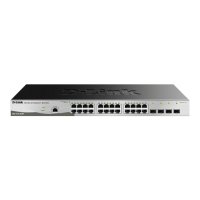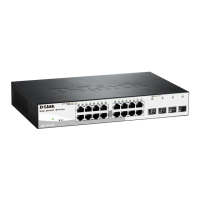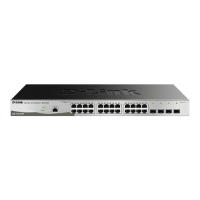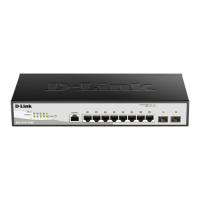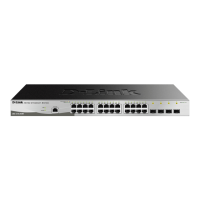5 Command Line Interface D-Link Web Smart Switch User Manual
upload { firmware_fromTFTP | cfg_fromTFTP } {<ipaddr> |
<ipv6addr>} <path_filename>
The upload command uploads the Switch’s current settings to a
TFTP server.
firmware_toTFTP − Upload the firmware on the Switch from a
TFTP server.
cfg_toTFTP − Specifies that the Switch’s current settings will be
uploaded to the TFTP server.
<ipaddr> − The IPv4 address of the TFTP server.
<ipv6addr> − The IPv6 address of the TFTP server.
<path_filename> − The filename of the firmware or switch
configuration file on the TFTP server. You need to specify the
DOS path if the file is not at the root directory of the TFTP server.
Example usage:
To upload a firmware file:
DGS-1210-28>upload firmware_toTFTP 1.1.1.23 1\running—config
01–Jan–2000 01:26:11 %COPY–I–FILECPY: Files Copy – source URL
running–config destination URL tftp://1.1.1.23/1\running–config
…..01–Jan–2000 01:26:16 %COPY–W–TRAP: The copy operation was
completed success fully
!
158 bytes copied in 00:00:05 [hh:mm:ss]
DGS-1210-28>
To configure the System IP interface.
config ipif system { ipaddress <ip-address> <subnet-mask>
gateway <gw-address> | dhcp | bootp }
The config ipif system command configures the System IP
interface on the Switch.
ipaddress <ip-address> <subnet-mask> − The IP address and
subnet mask to be created. Users need to specify the address
and mask information using the traditional format (for
example,10.1.2.3/255.0.0.0)
gateway <gw-address> − The IP address of the router or
gateway.
dhcp − Allows the selection of the DHCP protocol for the
assignment of an IP address to the Switch’s System IP interface.
bootp − Allows the selection of the BOOTP to the switch.
Example usage:
To configure the IP interface System:
DGS-1210-28> config ipif System ipaddress 10.48.74.122/8

